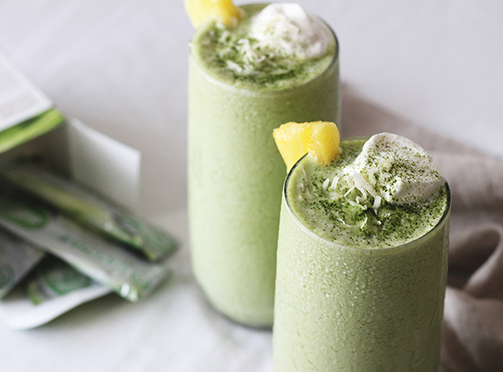

#Aiya sweetened matcha to go full#
Since, when you consume matcha, you’re consuming the entire tea leaf rather than an infusion, matcha is packed full of even more benefits than a typical tea. Matcha contains many of the same benefits as green tea, but in a much more concentrated form. Matcha is best described as having a much more concentrated green tea flavor, with an oceanic taste and sweet and slightly bitter notes. The shading process matcha tea plants undergo before harvest also contributes to their high caffeine content.Īntioxidant content - Green tea is already extremely high in antioxidants, but because matcha is a much more concentrated form of green tea, the antioxidant levels are correspondingly higher.įlavor - Green tea has a broader range of different flavor possibilities, and can be mellow, floral, nutty, vegetal, and more. fine powder) is one of the main differences between matcha and green tea.Ĭaffeine content - Because matcha is much more concentrated than green tea, it also tends to be much higher in caffeine. The final consistency of the leaves (whole leaves vs. Matcha has many of the same initial processing stages as green tea - the leaves are harvested and steamed to halt oxidation, then stone-ground into a fine powder. The tea leaves are then shaped, dried, and packaged. Japanese green teas tend to be steamed, while Chinese green teas tend to be pan-fired. Processing method - Green tea is either steamed or pan-fired after harvest in order to halt oxidation. Green tea is grown in China, Japan, and other Asian countries like Vietnam. These include:Ĭountry of origin - Matcha is produced primarily in Japan, and is a significant part of Japanese culture and cuisine. While green tea and matcha share many similarities, there are some important differences between these two types of tea. What’s the difference between green tea and matcha? Matcha can also be used in many different recipes, from smoothies to baked goods and more. You can do this by whisking together matcha powder, steamed milk, and a sweetener of your choice, then topping with frothed milk for a creamy, sweet latte that’s full of flavor. The sky’s the limit when it comes to culinary grade matcha! Many people use culinary grade matcha to make tea lattes. Culinary grade matcha tends to have a bolder, less nuanced flavor designed to stand up to other ingredients. It is usually less expensive, and is designed to be added to lattes, smoothies, baked goods, and other recipes. New to matcha and not sure where to begin? Our matcha starter kit contains everything you need to make matcha from the comfort of your kitchen.Ĭulinary grade matcha is a slightly lower grade of matcha than ceremonial grade matcha.
#Aiya sweetened matcha to go free#
Preparing matcha is largely a matter of personal taste, so feel free to play around with these ratios to figure out what works best for you! Then add up to 6 ounces of water, and whisk until frothy. Sift the powder into the bowl, then add a small amount of hot water and whisk until smooth. First, scoop the matcha powder into a sifter (we recommend about two scoops, or one teaspoon, of matcha powder per bowl.) Matcha is traditionally prepared using a whisk, scoop, sifter, matcha bowl, and hot water heated to approximately 175 degrees. It tends to be slightly more subtle and nuanced than culinary grade matcha, and should be consumed on its own rather than added to lattes and other confections. Ceremonial grade matcha is the highest quality grade of matcha. What is ceremonial grade matcha?Ĭeremonial grade matcha is a type of matcha that is designed to be used in a traditional Japanese tea ceremony. Today, matcha is primarily associated with Japan, and has a rich history and cultural significance within the country. Over centuries, an intricate tea ceremony surrounding matcha was developed. The ritualized use of matcha by Japanese monks grew quickly, and by the 15th century, its popularity had spread to Japan’s upper classes.

In the 12th century, Chinese monks brought both Buddhism and matcha to Japan. Powdered green tea was first produced in China during the Tang Dynasty. They are then stone-ground into a fine powder and packaged for sale. After the tea leaves are harvested, they are steamed in order to halt the oxidation process. These tea leaves are also used to produce specialty Japanese green teas like Gyokuro and Kabusecha.

The tea plants used to make matcha are shaded for the last few weeks leading up to the harvest, which results in a dark green tea leaf that contains higher levels of chlorophyll, caffeine, and l-theanine. It has a bright, emerald green color and a rich, vegetal taste. Matcha is a fine powder made from green tea leaves.


 0 kommentar(er)
0 kommentar(er)
